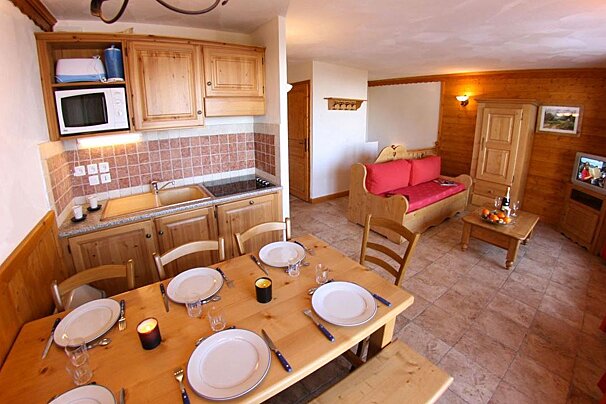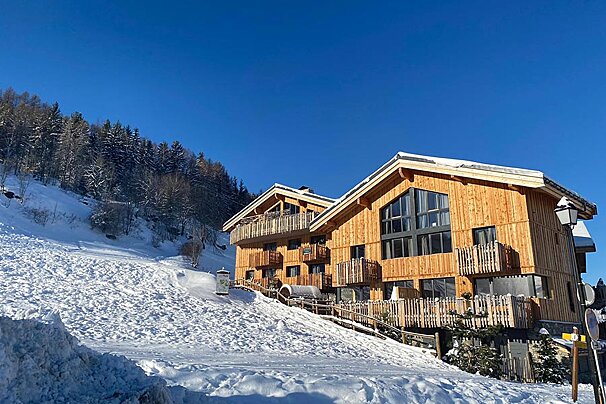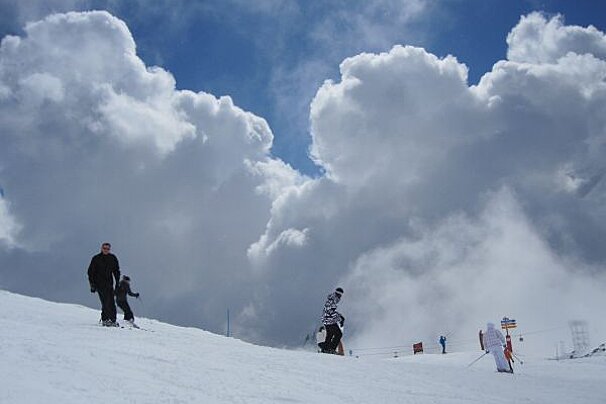Ski Area in Les Arcs
Discover the best of the Les Arcs ski area
Les Arcs is part of the Paradiski ski area, one of the largest in Europe and the second biggest linked ski area in the world. With its modern lift system and wide range of pistes, it's a ski destination that will suit everyone.
The main things to know about Les Arcs ski area are:
Snow-sure high altitude skiing
Over 70% of the Paradiski ski area is above 2,000m, which means plenty of snow throughout the season.
Great for families and beginners
Selection of beginner areas and ski-in/ski-out access.
Part of the Paradiski area
The second largest ski area in the world, linked with La Plagne and Peisey-Vallandry since 2003.
Easily accessible
By air, train, coach or self-drive there are numerous routes to easily get yourselves here.

Les Arcs ski area
Les Arcs is comprised of four village resorts:
- Arc 1600
- Arc 1800
- Arc 1950
- Arc 2000
No matter where you stay, you have access to the whole Paradiski area, plus its two glaciers (at over 3,000m), two snowparks, and around 150km of cross-country ski trails.
Taken independently, Les Arcs is made up of 137 pistes including 63 blue and 45 red pistes. There are also 12 green pistes and 17 black pistes, all accessed by 53 ski lifts, a high point of 3,226m and excellent snow-making facilities that guarantee back-to-resort skiing all season long (see the piste maps).
Arc 1600
South-west facing, providing extensive tree-lined skiing enabling descents to the unspoilt villages below resort level.
An “all weather” ski area
Holds the snow well, but the abundance of artificial snowmaking machines means you are virtually guaranteed to be able to ski back to the village.
Arc 1800
Sits around the tree line and is surrounded by wide, sunny, pistes that offer plenty of room for those on their first week. 90% of the runs into resort are graded blue, making it a great base for beginners and intermediates.
What to avoid in Arc 1800
It's best to try to avoid the bottom of the Maïtaz, Villards and Charmettoger runs where they converge at the Transarc gondola; this is usually teeming with people and, as it can get very icy, can catch out even the best of us, so try to use the mid-station point of the Transarc to get up and over to 2,000m.
Arc 2000
More suitable for intermediate to expert skiers as the runs here tend to be reds and blacks.
Challenging runs off the Aiguille Rouge glacier
More advanced skiers will find the longest run in resort, 7km long with 2,100m of vertical drop!
But don’t miss out on Arc 2000 if you are only just beginning to ski or snowboard as there are some fantastic rolling blues which are shallow enough for you to learn on.
Arc 1950
The more recently built neighbour to Arc 2000, it also gives you swift and easy access to the more challenging runs in the area.
Ski back to the heart of the resort
Built with convenience in mind by Intrawest (who also built Whistler in Canada), you can ski back and step out of your skis at the door.
Peisey-Vallandry
Many beautiful tree-lined pistes which are perfect for beginners. Despite being the gateway to La Plagne (via the Vanoise Express), this tends to be the quieter side of the valley. There is a good mixture of blue and red runs in this sector, allowing you to choose your difficulty at the top of virtually every lift.
Perfect tree-skiing
There are some wide-open pistes higher up, but if you like to ski between the trees then this is the place to do it. When the snow has dumped, the slopes around Peisey-Vallandry can seem almost heavenly.

La Plagne ski area
A purpose built resort La Plagne is actually a number of villages all offering something different. Whilst beginners are unlikely to head here from Les Arcs, there are some very long cruisey slopes, several snowparks, whilst the off-piste areas allow you to explore more of this beautiful region. Plus there's around 80km of cross-country skiing, a half pipe, and it's the only resort in France with an Olympic bobsleigh track.
The villages to know are:
- Belle Plagne
- Plagne Bellecote
- Monchavin
- Les Coches
- Plagne Soleil
- Plagne Village
- Plagne Centre
- Plagne 1800
- Champagny
- Aime 2000
- Montalbert
- Longefoy
It has a total of 135 pistes, with 74 blue pistes and 34 red pistes it's an intermediate skier/snowboarder's dream resort. If you're interested in learning more, take a look at seelaplagne.

When is the ski area open in Les Arcs?
The winter season usually runs from mid-December to mid-April, with any early lift openings depending on snow conditions.
Your holiday will be very much determined by the weather and snow conditions, and therefore the time of year you choose to visit is important. If it's sunny pistes and a cold glass of wine on a mountain restaurant terrace, come in March or April. If your perfect ski break is about quiet slopes and lots of fresh snow, then January is the time to come. Or if you want numerous activities organised for your children during their school holidays, February is for you.
Whenever you choose to come, as long as the lifts are open, the local pisteurs will make the best of the snow (real and/or artificial), and groom the pistes to perfection so that you get the best possible conditions.

Advanced areas in Les Arcs
Les Arcs and the extended Paradiski area offers a large selection of off-piste lines and difficult pistes for the more advanced skier or snowboarder, as you'd expect from one of Europe's largest ski areas.
Download the Les Arcs piste map
In the Paradiski area there are over 75 red runs and 35 black runs, and approximately 70% of the ski area sits above 2,000m.
Challenging skiing on the Varet glacier
Head to the Aiguille Rouge cable car and high above Arcs 2000 you'll find the longest run in the area, a black run that goes all the way down to Villaroger. It's 7km long with over 2,000m vertical drop. In unfavourable conditions the steep drop in at the top can be very icy and sheer. If you don't fancy the top section, take Arandelières as it meets the same run on the Glacier du Varet.
The Aiguille Rouge/Varet area is home to the Kilometre Lancé (Flying Kilometre) run. You can't do this run unsupervised, but it is possible to put yourself against the clock through the Les Arcs Club des Sports. You will often see the speed skiers in their space suits training hard on this piste, attaining speeds of over 200km/h.
Ecureuils is a black with a steep bottom section, Fond Blanc is a perfect black run as it's short and sweet and then joins a blue run above the snowpark.
Take on some great reds
Including Bette, Malgovert and Myrtille. Belette is fast and steep before eventually levelling off, Malgovert is never pisted so that leaves its own obstacles, and Myrtilles is a tree run that is fast and wide with sweeping corners and a consistent gradient.
Surprisingly steep Arc 1600
Try Cachette, it is broad and carvers love it.
Alternatively Aigle cuts through the woods above Vallandry ending at the Grizzly lift, and is a favourite of ours - never too steep, never too flat, and the trees aid the visibility in low light.

Bad weather areas in Les Arcs
In Les Arcs head to the lower resorts of 1800, 1600, Plan Peisey and Vallandry. The trees line the slopes here and there are some lovely rolling blue runs through the trees from 1800 to 1600 from the top of the Chantel or Les Villards chairs.
For some off-piste in the trees try either side of the Vanoise Express and stay between 1,950 and ,1300m where the tree-line is.
Keep in mind that the valley itself can be covered in an all-encompassing fog, but the top of the mountains can be bathed in glorious sunshine. Best thing to do is to check out our Les Arcs webcams.
Also, if it’s lashing down with rain in the valley, it means it’s snowing up top. If you can take advantage of days like these, you'll often have great stashes of fresh powder all to yourself.

Beginner and family areas in Les Arcs
A great resort for families as well as beginner skiers, each area has a number of easy blue runs and areas designed specifically for the beginner skier or snowboarder, you'll feel comfortable to learn anywhere in Les Arcs.
Arc 1600
There are lots of blues which run through the trees. It's a good place to progress from skiing blues to reds. Cachettes and Vezaille are a couple of good chairs to lap, building up your confidence before heading onto longer runs further up the mountain.
Arc 1800
Mille8 has a peaceful zone for beginners, which should be free of any other mountain users coming down at high speeds. You'll find peaceful tree-lined runs here that lead back to resort and are a great area for practising those turns. The 'front des neiges' here is home to the Jardin des Enfants, the nursery slopes and the ski school meeting points. Take the Carrely and Villards chairs to access the easiest skiing.
Arcs 2000
Once you're ready to progress, the blue runs from the top of the St Jacques chair in Arc 2000 are nice. Generally considered better suited to intermediate and expert skiers, this area does have some nice rolling runs - Plan Vert or Cascades.
Pesiey-Vallandry
Tree-lined blues perfect for beginners. Use the Peisey chair and the Cabri J bar, or in Vallandry take the Vallandry chair and the Flocon J bar.
Villaroger
The lowest of the Les Arcs villages, there is a small selection of blues that can easily be lapped via the Replat chair.
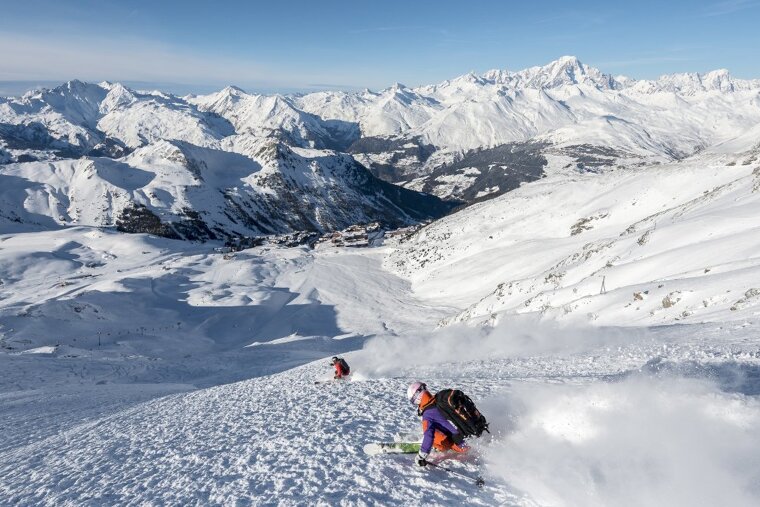
Off-piste areas in Les Arcs
Even with its reputation of being a great place to ride powder, it takes a surprisingly long time to become tracked, unlike many other Alpine resorts. There are some areas which will hold fresh snow longer than others and, like all ski areas, you’re more likely to get powder higher up.
The Grand Col
An off-piste playground that sits above 2,500m and keeps snow fresh for a long time. Lower down there is plenty of off-piste from the top of Arc 1800's Vagere lift around the Golf and Vagere red runs.
Where else to head
If you're new to off-piste try the wide, open area above Peisey-Vallandry, around the 2300 lift. Although mostly groomed, there will be some patches left unpisted which can be great fun after a snowfall.
There are plenty of forest runs near the Derby lift, there's also lots of woodland leading down to and beyond Arc 1600.
Always make sure you are prepared before embarking on any off-piste skiing or snowboarding. Check out our avalanche safety guide. It's always advisable to hire an off-piste guide who will have extensive knowledge of the area and the mountains.
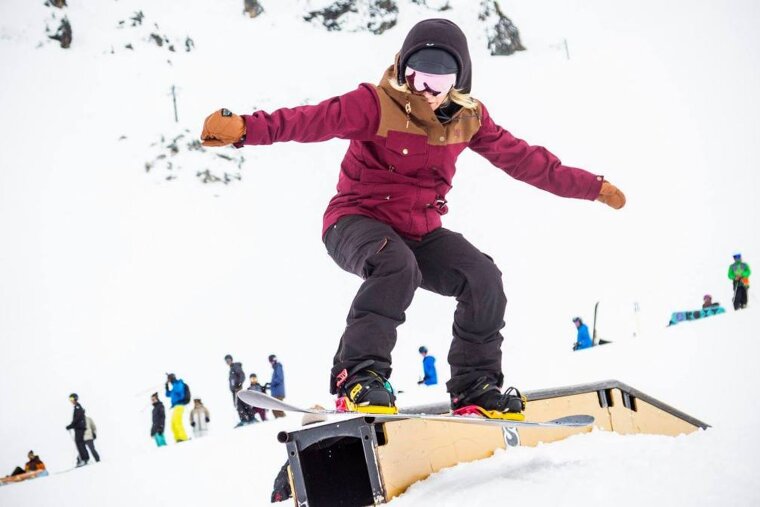
Snowparks in Les Arcs
There are two snowparks here.
Apocalypse
Between Arc 1600 and Arc 1800, next to the Snowpark lift. There's lots on offer here from blue level jumps and features to black kickers, rails and a quarter pipe. You'll also be able to enjoy rail slides, a spine and a gap jump for the adventurous.
There's also a boardercross up here for those looking to test their speed and an airbag that's free to use.
Mille 8
The features include something for everyone, so if this is your first time in the park don't worry, just stick to the green lines. There are lights and a sound system, plus you can tag your photos to appear on the big screens around the zone.
Access is via the Villards gondola and entry is included in your lift pass.
More inspiration...
Whether you're into mogul fields, steep descents, quiet tree-lined pistes with great snow or just somewhere to rediscover your ski-legs, there is a piste in Les Arcs just for you, just take a look at our best pistes in Les Arcs.
Take a look at this year's ski pass prices for which pass to buy.





